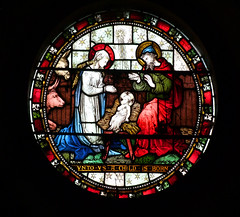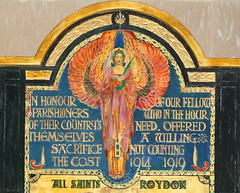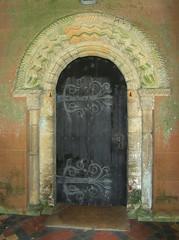| |
|
All
Saints, Roydon
 |
|
Not
to be confused with the Roydon near Diss, this
little village sits out in the mazy lanes to the
south of the Sandringham estate. Like many around
here, the church is kept locked, but there was a
keyholder notice, and also a very affable old
gentleman who was happy to lend me the key. The
church sits back from the lane, and your first
impression is of the solid 14th Century tower,
and then the sequence of curious round-headed
windows picked out in polychromatic brick down
the north side of the ashlar nave. There is a
surviving Norman doorway on the north side, and
an even better one in the south porch. On the
doors themselves, the ironwork is flourishing but
not ornate, and what strikes you is the sheer
quality of it. Surely it is not the work of some
simple village blacksmith? The answer
is no, it almost certainly wasn't. The tower
survives from a medieval predecessor, but the
rest of the church was entirely rebuilt by the
young George Edmund Street in 1857. This is
interesting for all sorts of reasons. At the
time, Street was making a considerable name for
himself. He had worked for five years in the
office of George Gilbert Scott, carrying out his
own commissions, including entirely new churches
as well as restorations, mainly in Cornwall. An
enthusiast of the Ecclesiological Revival which
had inevitably followed the wave of excitement
created by the Oxford Movement, Street was
appointed Diocesan Architect to the Diocese of
Oxford in 1850. He was just 26 years old.
|
By 1855,
his increasing reputation enabled him to set up in
practice for himself, in London, and he entered designs
for a number of competitions for secular buildings in the
city that were going up in the new gothic style. Mostly,
he was unsuccessful, but one of the first churches he
received a commission for as an independent architect was
this one, All Saints at Roydon.
Now, we
think of Street as one of the half dozen top architects
of the Gothic Revival, so it comes as some surprise to
discover that All Saints was rebuilt in a neo-Norman
style. But this was just a year or so after the
publication of his book The Brick and Marble Architecture of
Northern Italy, so perhaps his mind wasn't yet fully
focused on the pattern-book English gothic of his friend
Butterfield's All Saints Margaret Street. Pevsner seems to
think that Street would have been reluctant to essay into
neo-Norman, but if he was, he made a pretty good job of
it.
There is a
pleasing harmony to the building, the details taking
their key from the surviving doorways. The glass of
Clayton & Bell (east), depicting the Crucifixion
flanked by the Resurrection and the Ascension in three
lancets with a roundel of the Nativity above, is an
unusual choice for neo-Norman, but once again it works
very well, as does the west window depicting St Peter and
St John, which Mortlock thought was probably by William
Wailes. The font is grand, the pulpit, albeit in wood,
echoes the neo-Norman style of the building. It should
all be terribly kitschy, but somehow the quality of the
work shines through, and there is a quiet gravitas to the
interior that I had not expected. Is there a reason for
this?
Well,
perhaps there is. In January 1856, Street took on as an
apprentice a maverick genius by the name of William
Morris. The 21 year old Morris was just down from Oxford,
where he had studied classics, but his real interest had
been in medieval art and architecture. He had known the
older Street in Oxford, and shared his passion for the
work of Pugin and Ruskin. Morris's arrival must have been
like a firework going off in Street's office. His
obsession with detail, his puritanical rejection of
mainstream artistic tastes, his dislike of urban life and
his longing to return to the idyllic simplicity of
medieval rural life and manners - is it wishful thinking
to see these things reflected in Street's All Saints,
Roydon? At the very least, can we assume that the
ironwork of the doors may have come from Morris's
influence, and possibly even his design?
| Morris
did not stay with Street for long, for soon his
obsessions were all consumed by the
Pre-Raphaelite Movement. He would never complete
his apprenticeship. But for a year and a bit, two
of the great figures of 19th Century art and
architecture were working together here at lonely
Roydon All Saints, an extraordinary thought. Both Morris
and Street were long in their graves when the
final little touch which makes Roydon All Saints
even more special was installed. This is the
First World War memorial board. Probably by a
local hand, it has been painted vividly in a
pious 1920s style at the point where late Art
Nouveau is tipping into Art Deco. This kind of
folk art is a precious touchstone down the long
generations, to be treasured and preserved. A
great angel, a crucifixion and a couple of
haunting little vignettes of soldiers flank the
names of the five boys who never came back.
|
|
 |
|
|
|



